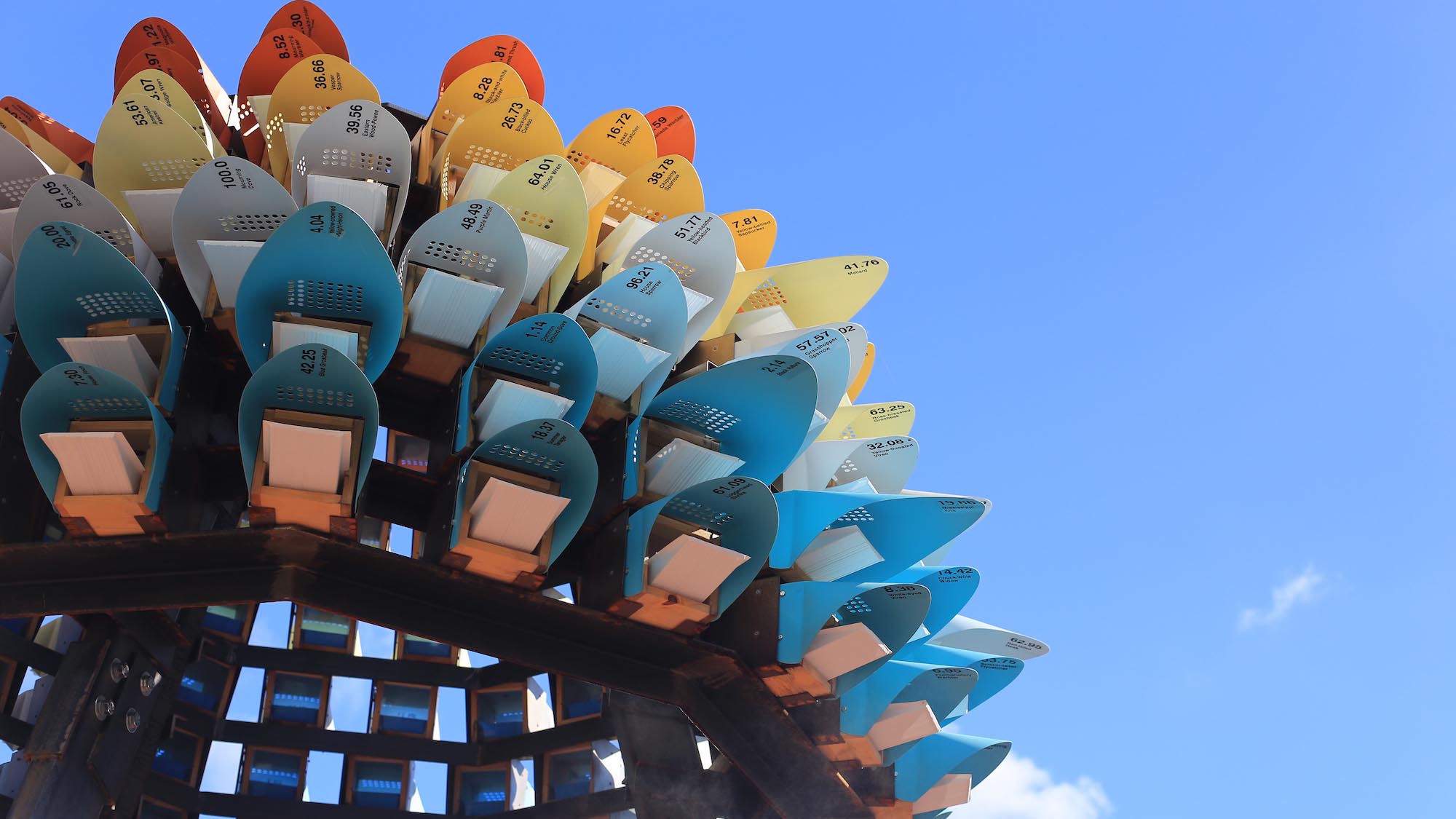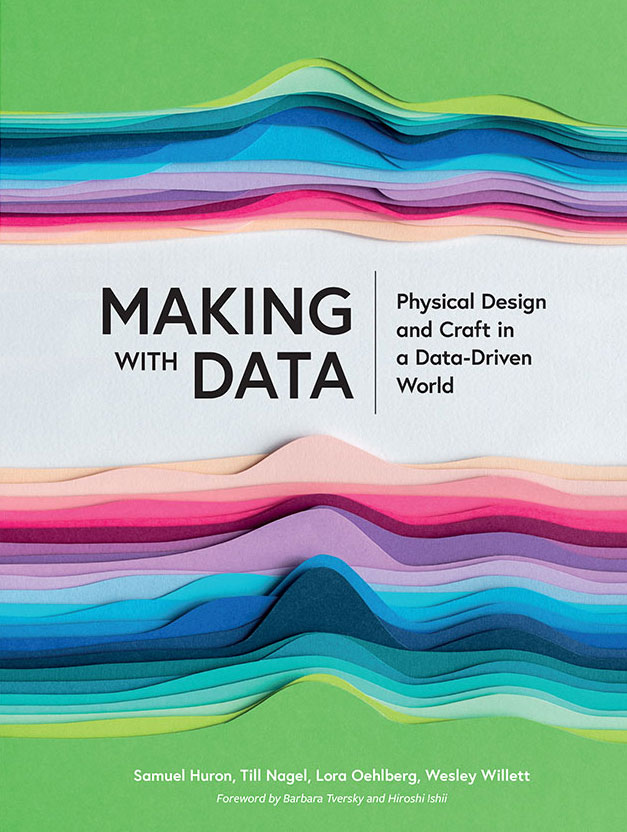Orbacles makes scientific data tangible via a site-specific triad of sculptures that connect visitors to the reality of climate change through the story of changing Minnesota bird populations given current and future predicted climate scenarios.
Motivation & Inspiration
After designing site-specific installations for three annual Northern Spark one-night arts festivals in Minneapolis, Postography (2014), Cityscope (2015), and Weather Report (2016), our design collective of architects, landscape architects, and computer scientists wished to cre- ate a more permanent and impactful work. We designed Orbacles in response to the 2017 Creative City Challenge, a competition that asked artists to explore the effects of climate change on the city and its residents via an installation at The Commons park, Minneapolis. The design’s intentional connection to the city and its residents builds upon our earlier installations, and the themes of data physicalization and changing climate are a direct extension of Weather Report, a tunnel of interactive balloon pixels installed on the banks of the Mississippi river at the 2016 Northern Spark festival.

Recognizing that the timescale and underlying data-intensive evidence for climate change often feel out of reach to the average citizen — either too complex to interpret or only accessible by supercomputer — we thought, how can we make climate data and the local impact tangible?

Inspired by the city’s birds, we thought, here is an aspect of the city that the changing climate will surely impact. What will it be like to visit this park hundred years from now? What birds will be here? Which ones will have disappeared or moved in? And how can we tell this story using the same real numerical data ornithologists and other scientists use to answer these questions?
The installation
Final piece installed at The Commons. Each of the three orbs holds 147 modules, one for each bird species in Minnesota. The length of each hood varies in response to the average size of the species, and the color is based on the prevalence of the species in Minnesota. The color white represents the current state. So, the “Current” orb in the middle contains all white modules, showing the bird species currently present in Minnesota.




The two colored “Future” orbs shown represent scientific simulations of Minnesota 100 years from now under two possible scenarios. The low-emissions scenario models a future that would require us to make aggressive changes in our policies to limit greenhouse gas emissions. The high-emissions scenario (right image) models a future based on continu- ing current policies. If the species decreases in prevalence within the state, the color of the hood tends toward orange, and if it increases in prevalence (e.g., some species will migrate north to enter Minnesota) it tends toward green.
The sculptures include a didactic explaining the underlying data, including a link to our website that includes an interactive web visualization using the same data mappings.
Visual Encoding
Practices and Processes
Lorem ipsum
Concept sketches
We explored the concept of a modular habitat for birds with concept sketches and mockups. The modules needed to be functional, acting as a habitat for birds, while also being held aloft so that visitors could not climb on them and being robust enough to withstand the elements.
Paper mockups
While exploring various winged forms, we discovered several ways (hood length, hood tilt, color, placement within the “nest”) to parameterize the design of each module, making it possible to tune each based on underlying data for each bird species.
Digital modeling
We created digital models and renderings using Rhinoceros and Grasshopper to understand how the modules would fit within each orb and how the final piece might feel when installed on site.
Fabrication shop
The metal hoods and frames were fabricated by our partners at MG McGrath, while the wooden module boxes and formed plastic inserts for baths were fabricated by hand in the UMN School of Architecture workshops.
Installation on site
Installation on site required some heavy machinery.
Projection
A flocking simulation written in Processing and interactive webpage written in D3 brought the sculptures to life on opening night at the Northern Spark Festival.
Afterlife
The installation in downtown Minneapolis was temporary, but the modules have an afterlife, providing a habitat for birds around the city.
Materials and Tools
- Sketching
- Paper folding
- Woodworking
- Sheet metal bending
- Vacuum forming plastic
- Custom computer graphics programming with Processing and D3
- Parametric digital modeling with Rhinoceros and Grasshopper
Reflections
The MINN_LAB design collective brings together researchers and practitioners from multiple disciplines. Communication and building consensus will be a challenge in any such situation, but this project managed some great successes on these fronts and resulted in a design that pushes the boundaries of research in multiple disciplines.
Within the field of data visualization, the project asks us to consider what it takes to make scientific data more accessible and relevant to the average person. In a context where even our most scientifically robust climate data and conclusions are routinely called into question in the public sphere, these data and the science behind them can feel aloof, mysterious, and hopelessly uninterpretable to many in society. Orbacles asks us to reflect on how the way we “visualize” such data might change this. How will people react to climate data when, rather than stuck within a database, the data become so real that we can touch, smell, or taste them?
Similarly, within the field of architecture, Orbacles prompts us to consider how we might legibly incorporate various kinds of data into the design of our built environment to not only shape the forms we see and inhabit, but to also influence how we relate to these data-informed places and the broader implications of the data. Orbacles explores a model where housing accommodates rather than resists, shelters rather than defends, and partners rather than fights with local animals and plants. Additionally, the project outlines an expanded agency of the architect, taking control of the full lifecycle of a structure in order to plan its future material use after disassembly. How does a structure bring users into dialogue with place, and how do we plan for its reintegration into systems of materials use once its current manifestation is no longer relevant?
Find more information at https://www.tenxtenstudio.com/orbacles and http://minnlab.squarespace.com/orbacles.

